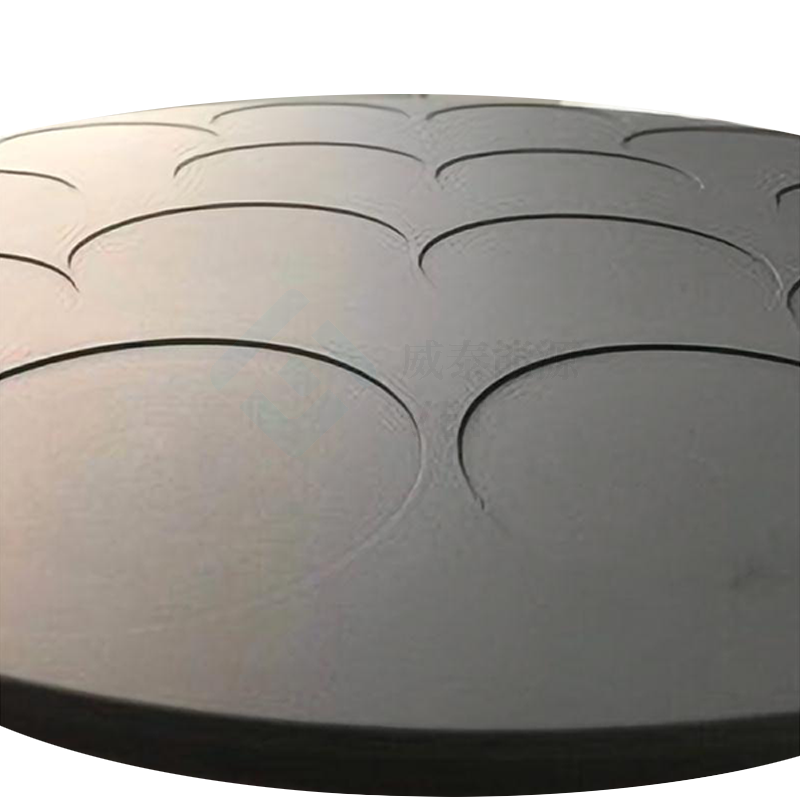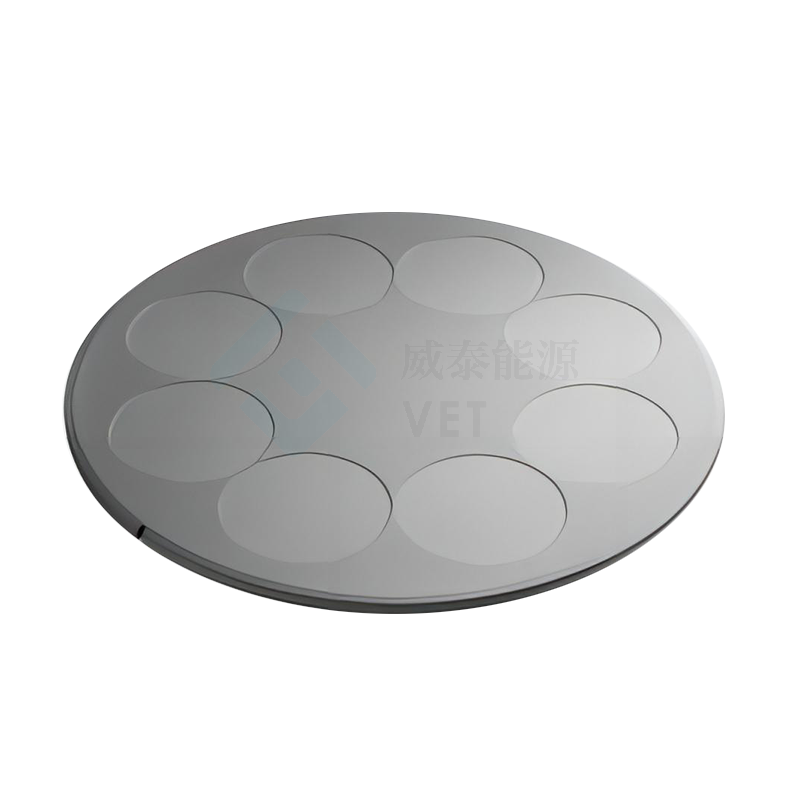炭化ケイ素(SiC)コーティング コレクタートップは、その優れた特性により、半導体製造に不可欠です。これらのSiCコーティングは1600℃までの温度に耐え、200W/m・Kの高い熱伝導率を提供し、効率的な熱放散を保証します。コレクタートップ シックコーティングプロセス は、過酷な環境下で部品の完全性を維持する耐酸化性と汚染防止機能を提供します。のリーダーである寧波VETエネルギー技術有限公司(Ningbo VET Energy Technology Co. SiCコーティング イノベーションは、熱特性と耐食性を最適化することで工業プロセスを強化する。同社のソリューションは、半導体や太陽光発電などの分野をサポートし、産業界への影響力を示している。

要点
- SiCコーティング 1600℃までの高熱に対応します。これにより、高温の半導体プロセスでも工具を安定させ、良好に動作させることができます。
- これらのコーティング 工具を長持ちさせる 錆や汚れを防ぐ。つまり、修理の回数が減り、コストが下がる。
- SiCコーティングは、半導体をクリーンな状態に保つことで、半導体をより良いものにするのに役立ちます。また、熱を均一に拡散し、製品の品質を向上させます。
SiCコーティングと半導体プロセスにおけるその役割
SiCコーティングの主要特性
炭化ケイ素(SiC)コーティングは、半導体製造に不可欠なユニークな特性を備えています。最高1600℃まで耐えられるため、高温プロセスでの安定性が保証される。また、200W/m・Kという高い熱伝導率により、効率的な熱放散を可能にし、熱応力のリスクを低減します。 SiCコーティング また、優れた耐薬品性を発揮し、部品を酸化や浸食から保護する。
SiCのβ 3C(立方晶)結晶構造は耐食性を高め、高密度で気孔率がゼロであるため、耐久性と漏れのない性能を保証します。これらの特性により、SiCコーティングは、精度と寿命が要求される半導体用途において信頼性の高い選択肢となっています。例えば、450GPaの弾性率は、機械的ストレス下でも構造的完全性を保証します。
高温環境におけるSiCコーティングの重要性
半導体プロセスにおける高温環境では、性能を劣化させることなく維持できる材料が要求される。SiCコーティングはこのような条件下で優れた性能を発揮し、グラファイトや石英のような従来の材料を凌駕します。その耐酸化性は、過酷な条件下でもコンポーネントの完全性を保証します。
例えば、エピタキシーや化学気相成長(CVD)プロセスにおいて、SiCコーティングはウェハーに安定したプラットフォームを提供します。この安定性により、熱分布が均一化され、熱応力が最小限に抑えられ、製品の品質が向上します。さらに、化学反応に対するバリアとして機能するこの材料の能力は、グラファイトコアを浸食から守り、装置の寿命を延ばします。
半導体製造装置への応用
SiCコーティング は、さまざまな半導体製造装置で重要な役割を果たしています。SiCでコーティングされたキャリアは、熱安定性と耐汚染性を高め、効率的なウェハープロセスを保証します。高温装置は、安定したプラットフォームを提供するSiCの能力から恩恵を受け、作業中の熱ストレスのリスクを低減します。
エッチング装置や蒸着装置もまた、侵食性の高い化学反応から保護するためにSiCコーティングに依存しています。この保護により、厳しい環境下でも装置の構造的完全性が保証されます。例えば、SiCコーティングは、一貫した性能を維持することが重要な結晶成長や酸化などのプロセスにおいて不可欠です。
SiCコーティング・コレクター・トップの用途

エピタキシャル成長プロセス
SiCコーティング・コレクター・トップ は、基板上に結晶層を成膜するエピタキシー工程で重要な役割を果たします。これらのコーティングは、酸化や汚染を防ぐことにより、半導体製造装置の性能と寿命を向上させます。これにより、欠陥のないシリコンウェーハやLEDの製造に不可欠なエピタキシャル層の品質が保証される。
エピタキシャル成長中、SiCコーティングは、プロセスの一般的な副産物である原子状水素との反応からコンポーネントを保護する。この保護は、装置の構造的完全性を維持し、高品質のエピタキシャル成長を保証するために不可欠です。さらに、SiCコーティングは、ラピッドサーマルプロセッシング(RTP)やラピッドサーマルアニール(RTA)のような精密加工に不可欠な最適加工温度を維持します。
化学気相成長法(CVD)
化学気相成長(CVD)プロセス、 SiCコーティング は、効率と製品品質の両方を向上させます。その熱安定性は、均一な材料成膜に不可欠な一貫した温度制御を保証する。この安定性は欠陥のリスクを低減し、半導体製造の歩留まり向上につながります。
SiCコーティングはまた、優れた耐汚染性を提供し、CVD中のクリーンな環境を維持する。この清浄性は、高品質の基板を実現するために不可欠である。さらに、SiCコーティングの耐久性は、装置を摩耗や損傷から保護し、動作寿命を延ばし、メンテナンスコストを削減します。
酸化と拡散プロセス
半導体製造における酸化・拡散プロセスでは、純度を保ちながら高温に耐える材料が必要とされます。SiCコーティングは、不純物に対する効果的なバリアとして機能し、最終的な半導体製品の完全性を保証します。その化学的不活性は汚染を防ぎ、装置の性能と信頼性を維持するために極めて重要です。
耐摩耗性と耐腐食性により、SiCコーティングはこれらのプロセスで使用されるコンポーネントの耐久性を向上させます。この耐久性は、過酷な環境下でも安定した性能を保証し、SiCコーティングを酸化や拡散の用途に不可欠なものにしています。
SiCコーティング・コレクター・トップの利点
耐久性と寿命
SiCコーティングが耐久性を高める は、機械的ストレスや表面劣化から部品を保護することにより、半導体製造装置のこれらのコーティングは1600℃までの温度に耐え、高温環境下でも安定した性能を発揮します。また、高い熱伝導性により効率的な熱放散を促進し、熱による損傷のリスクを低減します。このような特性の組み合わせにより、SiCコーティングは、信頼性の高い材料を必要とする産業にとって費用対効果の高いソリューションとなっています。
SiCコーティングは、広い温度範囲にわたって構造的に安定しているため、機器の寿命を延ばします。摩耗や腐食に耐えることで、このコーティングは頻繁な交換の必要性を最小限に抑えます。例えば、結晶成長や酸化のようなプロセスで使用される部品は、SiCの汚染を防ぎ、化学反応に抵抗する能力の恩恵を受けています。この耐久性により、長期的な機能性が保証され、操業の中断やメンテナンスコストの削減が可能になります。
熱安定性と耐熱性
SiCコーティングは高温環境において優れており、グラファイトや石英のような従来の材料よりも優れています。極端な温度でも構造的完全性を維持できるため、要求の厳しいプロセスでも信頼性の高い性能を発揮します。例えば、エピタキシーや化学気相成長(CVD)において、SiCコーティングは均一な熱分布を提供し、これは高品質の半導体層を実現するために極めて重要です。
SiCコーティングの高い熱伝導率は耐熱性を高めます。この特性により、熱を効率的に放散し、熱応力の可能性を低減します。SiCコーティングは、過酷な条件下でも安定性を維持することで、半導体製造プロセスの全体的な効率と信頼性に貢献します。
効率と汚染防止
SiCコーティング 半導体の効率向上 ダウンタイムとメンテナンスを削減することで、製造業に貢献します。その頑丈な炭化ケイ素層は、化学的に侵食性の高い環境においても、摩耗や損傷から機器を保護します。この耐久性により、中断のない生産サイクルが保証され、頻繁な交換の必要性が最小限に抑えられます。
コンタミネーションの防止もSiCコーティングの重要な利点です。これらのコーティングは、滑らかでクリーンな表面を提供し、パーティクルの発生を抑え、ウェーハの純度を維持します。この清浄性は、精度と均一性が最も重要なエピタキシャル成長のようなプロセスに不可欠です。欠陥を防ぎ、一貫した性能を確保することで、SiCコーティングは製品の品質と歩留まりを向上させます。
ヒント SiCコーティングは装置を保護するだけでなく、製造工程を最適化するため、半導体業界では欠かせないものとなっている。
SiC コーティング・コレクター・トップは、半導体製造の効率と製品品質を大幅に向上させます。エピタキシー、CVD、酸化プロセスにおけるその役割は、高温環境におけるその重要性を浮き彫りにしている。ハイブリッド・コーティング材料やリアルタイム・モニタリング・システムのような革新は、業界を変革している。Ningbo VET Energy Technology Co.のような企業は、耐久性と熱性能のためにSiCコーティングを最適化することで進歩をリードしています。これらの開発により、SiCコーティングが将来の半導体技術に不可欠なものであり続けることが保証される。
製品の詳細については、下記までお問い合わせください。 steven@china-vet.com またはウェブサイト: www.vet-china.com.






